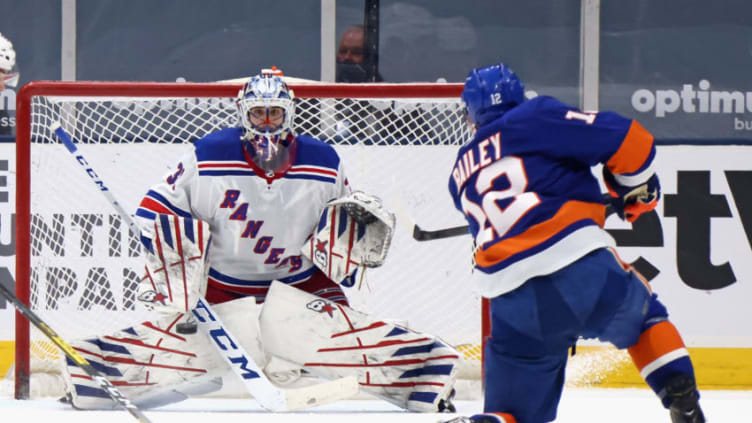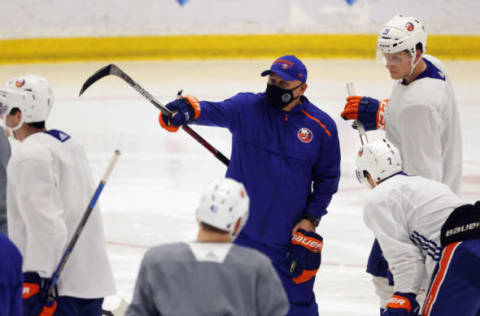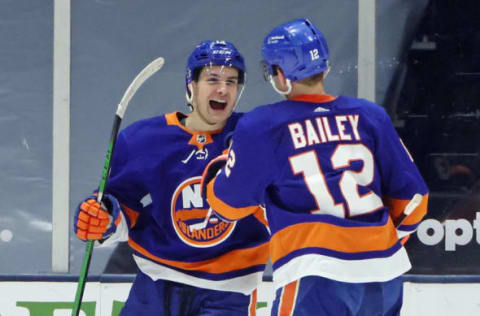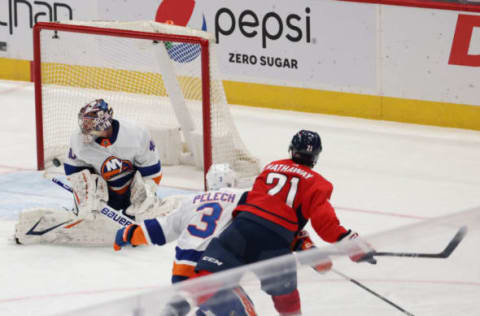Islanders: Three Takeaways from 6-1 Beatdown of Rangers


Tuesday night saw the New York Islanders bring the most complete effort we’d seen from them in a long time, as they cruised to a 6-1 win over the Rangers.
Unlike other recent performances, Tuesday marked an extremely positive return to form for the New York Islanders, as they beat the Rangers 6-1 and dealt a huge, perhaps lethal blow to their rival’s playoff hopes.
Here are three takeaways as the Islanders beat up on the Rangers and set the table for a crucial three-game set with the Washington Capitals on the horizon.
1. Trotz Finding Success in Shuffling Islanders Forward Group
While Tuesday was one of the most fun games the Islanders have played all season from a fan perspective, it’s not hard to remember the difficult trials this team underwent recently. Things were looking a little bleak for the Islanders coming off of a 2-2-0 week in which they continued to look as though they’d gotten away from their team identity.
In the midst of the tough stretch, and having been given several new players to work into his lineup, Barry Trotz began tinkering with his forward group. It wouldn’t be the first time Trotz has put his lines in a blender and found a hidden gem, but that appears to be what he’s done again coming off of Tuesday’s game.
These strong new lines in question are, of course, the Beauvillier – Pageau – Bailey line, and the Dal Colle – Nelson – Palmieri line. The former was responsible for three 5v5 goals in their 10:04 of action, while the latter created the most high-danger chances for (HDCF) and maintained the best possession metrics of all Islanders even-strength lines.
I think the line which has received the stiffer online opposition from within the fanbase that I’ve seen is the MDC – Brock – KP line. I understand why a lot of fans dislike Michael Dal Colle. He doesn’t produce offensively, he skates like there’s cement in his boots, and he does so while also being a former 5th overall draft pick in 2014, a draft that also saw the Isles select Josh Ho-Sang at 28th overall.
MDC doesn’t do anything that particularly impresses. He’s a good forechecker and puck retriever, but his reading of the game and skillset leaves him pretty much incapable of making plays happen off his retrievals. It’s frustrating watching him play because you can see the value in dressing him alongside more skilled teammates, but it so rarely leads to point production for Dal Colle.
As far as his analytical profile is concerned, Dal Colle is a replacement-level winger, as measured by his WAR. By the numbers, he brings about as much value as any other 13th forward would.
But Dal Colle’s underlying metrics are all pretty good in 2020-21, and he’s shown an ability to build chemistry with different linemates as this season has gone on. I liked MDC next to Brock Nelson and Jordan Eberle earlier this season, as that trio put up strong 5v5 numbers in a limited sample size. But, MDC – Brock – Palmieri appears to be a similarly strong unit.
Only growing the sample size will tell us whether these new lines Barry’s cooked up will be long-term solutions to the Islanders forward combinations problem. I don’t think the problem is fully solved by these lines either. There’s still the question of getting the Barzal line back to producing consistently. But, for now, I’d like to see these lines continue to be rolled. Let’s find out if they hold up well against Washington.

2. Bailey and Dobson’s Return, Fourth Line Leo, Varlamov’s Start
Despite a 1-0 victory to close out last week in Philadelphia, I think Islanders fans could see that the lines rolled in that game were not going to stick. Braydon Coburn and Andy Greene made for a really, really bad defense pairing, Oliver Wahlstrom continued to struggle, and Barry even went back to Leo Komarov on the first line again for about five minutes of 5v5 time.
That the Isles would need to continue shuffling things and finding what works was still evident, and so they kept making changes. Josh Bailey entered the lineup, having returned from a brief hiatus caused by what appears to be a minor injury. Noah Dobson also got back into the Islanders lineup after having been healthy scratched on Sunday.
Bailey and Dobson are two players who have had trouble finding their games this season. Bailey’s form has been frustrating fans all season, while the younger, more fresh-faced Dobson has been allowed to mostly slide for what have been some sub-par performances on the Islanders backline.
Maybe it’s fans recognizing Dobson plays with Andy Greene, who appears more cooked with each passing game, or maybe they’re just being nice because Noah has the attributes and skillset of a future top-pair NHL blueliner. But they needn’t feel frustration with the youngster on Sunday, as he and Greene played a fairly reliable brand of defense that saw their pair limit xGA despite ceding possession more often than not.
Bailey was not afforded any such mercy by fans, which makes it all the sweeter that he came back to score twice and add an assist in a big night for the Islanders veteran.
Exiting the lineup on Tuesday were Braydon Coburn and Oliver Wahlstrom. Coburn, as we’ve discussed, is best left playing a 7th or 8th defenseman role for this Islanders squad. Wahlstrom, while still bright and promising, has just not been the same since returning from two healthy scratches on April 8 and 9, so he too exited the lineup to give way for Bailey.
Cal Clutterbuck, also injured in recent action, did not return to the lineup on Tuesday. In his stead, Leo Komarov continued fulfilling the duties of the noble fourth-line winger. He threw a hit, he blocked a shot, he got under the skin of Rangers defenseman Adam Fox on several occasions. We love to see it. Leo is a natural as a bottom-six winger, and he’s probably better there than Clutterbuck at this point.
Finally, Semyon Varlamov returned to the crease on Tuesday. He saved 1.77 goals above expected (GSAx) and turned away all but one high danger shot in the outing. After the way in which fans had swooned over Ilya Sorokin’s shutout performance on Sunday, it’s nice to see Varly come back and remind us why he’ll likely get starting duties come playoff time.

3. Looking Ahead: Capitals Mini-Series
With Sunday’s win, the New York Islanders retained their seat in second place in the East Division. As Pittsburgh would go on to win 7-6 over the New Jersey Devils only a few minutes later, the win was important to keep the Isles ahead of the Penguins. But it was also important to keep them close to the team ahead of them, both in the standings and the schedule.
The Islanders and Washington Capitals will square off three times in the next seven days in a mini-series that will have potentially far-reaching consequences for the entire East Division. The Islanders and Capitals should be treating this set of games as the most important stretch of their regular seasons.
Not only does it provide an opportunity to get into that playoff mindset of seeing the same team more than twice in a row, but there are real implications at play here too. Whoever loses this mini-series runs the risk of being passed in the standings by the surging Pittsburgh Penguins or Boston Bruins.
Meanwhile, the winner will be growing their lead in the East, and could likely secure a path to a division title, and guaranteed home ice through two playoff rounds, via a regular-season “series” win.
This set will also provide an opportunity to feel the opposition out. As the Isles and Caps haven’t met since the trade deadline brought some new pieces to each side, there will be a chance here for the opposing coaching staff to review the tactical side of their game plans.
Washington is a quick-strike offense that creates a larger percentage of their shots off the rush than any other NHL team. The Islanders prefer to create offense off the cycle and forecheck. These two sides could not be any more different in terms of offensive tactics. The question for the coaches becomes how have the deadline acquisitions affected the opposition, and what adjustments have to be made to come out victorious?
It’s a matchup I really look forward to because when it comes down to it, it’s not just Islanders vs Capitals. It’s Barry Trotz vs Peter Laviolette. Two Stanley Cup-winning coaches with strong pedigrees who will attempt to work each other out and find a strategic upper hand over the other. The East Division could very well hang in the balance, and it should make for appointment viewing as three of the most important East Division games all season.